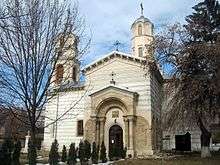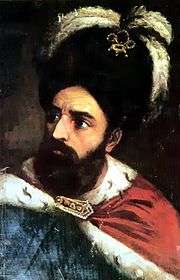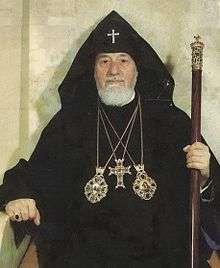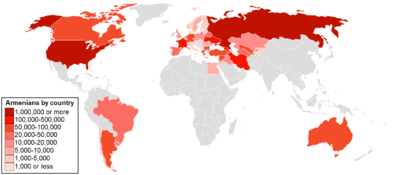Armenians of Romania
| |||||||
| Total population | |||||||
|---|---|---|---|---|---|---|---|
| (1,780 (2002)) | |||||||
| Regions with significant populations | |||||||
| Transylvania, Wallachia | |||||||
| Languages | |||||||
| Armenian, Romanian | |||||||
| Related ethnic groups | |||||||
| Armenian diaspora | |||||||
| Part of a series on |
| Armenians |
|---|
| Armenian culture |
|
Architecture · Art Cuisine · Dance · Dress Literature · Music · History |
| By country or region |
|
Armenia · Nagorno-Karabakh Republic Armenian diaspora |
| Subgroups |
| Hamshenis · Cherkesogai · Armeno-Tats · Lom people · Hayhurum |
| Religion |
|
Armenian Apostolic · Armenian Catholic Evangelical · Brotherhood · |
| Languages and dialects |
| Armenian: Eastern · Western |
| Persecution |
|
Genocide · Hamidian massacres Adana massacre · Anti-Armenianism |
|
Armenia Portal |
.png)
Armenians have been present in what is now Romania and Moldova for over a millennium, and have been an important presence as traders since the 14th century. Numbering only in the thousands in modern times, they were culturally suppressed in the Communist era, but have undergone a cultural revival since the Romanian Revolution of 1989.
History
Danubian Principalities
The earliest traces of Armenians in what was later Moldavia are dated by 967 (recorded presence in Cetatea Albă). Early Armenian Diasporas stemmed in the fall of the Bagratuni rule and other disasters, including the Mongol invasion. In 1572–1574, Ioan Vodă cel Cumplit was Hospodar (Prince) of Moldavia, grandson of Stephen the Great, son of Bogdan III and his Armenian concubine Serpega.
Armenian expatriates were awarded tax exemptions at different times in the Danubian Principalities' history. Encouraged to settle as early as the 14th century, they became a familiar presence in towns, usually as the main entrepreneurs of the community – for this, in early modern Botoșani and several other places, Armenians as a guild were awarded political representation and degrees of self-rule. A considerable number of noble families in the Principalities were of Armenian descent.
In Bucharest, an Armenian presence was first recorded in the second half of the 14th century – most likely, immigrants from the Ottoman-ruled Balkans, as well as from the area around Kamianets-Podilskyi and towns in Moldavia; throughout the 19th century, a large part of Armenian Bucharesters had arrived from Rousse, in present-day Bulgaria. The Gregorian Armenians were given the right to build a church around 1638 – it was rebuilt and expanded in 1685, but was damaged by the Russian attack during the 1768–1774 war with the Ottomans.
Citizenship was bestowed on the community only with the decision taken by the international protectorate over the two countries (instituted after the Crimean War and the ensuing Treaty of Paris) to extend civil rights to all religious minorities.
Transylvania
.png)
Armenians were present from early on in Transylvania, clearly attested in a document issued by Hungarian King Ladislaus IV the Cuman (late 13th century). Here, they were even allowed to found their own trading towns, the most notable one being Gherla, called Armenopolis/Armenierstadt or Hayakaghak (Հայաքաղաք). The second important Armenian town in Transylvania is Dumbrăveni (Elisabethstadt).
Despite their increasing autonomy, the townspeople's adherence to the Roman Catholic Church was nonetheless demanded (a conversion begun through the efforts of a Botoșani-born prelate, Oxendius Vărzărescu), and further submitted to forced integration by the Habsburg monarchy since the 18th century. The Ordinariate for Catholics of Armenian Rite in Romania is nowadays centered on Gherla, and is placed under the jurisdiction of the Romanian Roman-Catholic Church archbishops of Alba Iulia.
Most Armenians from Transylvania has been magyarized in the last half of the 19th century.
Romania
After the Armenian genocide of 1915, Romania was the first state to officially provide political asylum to refugees from the area.
In 1940 about 40,000 Armenians lived in Romania. Under communist rule, Armenians started to leave the country, and Nicolae Ceaușescu's regime eventually closed all Armenian schools.
Religion
The Armenian Apostolic community has a number of churches and a monastery in Romania. The church is under the jurisdiction of the See of Holy Echmiadzin of the Armenian Apostolic Church. The churches include:
- Episcopia Armeana Hreshdagabedats Mayr Yegeghetsi (Apostolic) (Bucharest)
- Holy Cross (Mănăstirea Hagigadar) Armenian Apostolic Monastery of the Wishes (Manastirea Dorintelor, Suceava)
- Armenian Apostolic Church of Iasi (Biserca Armeana Sf. Maria, Iași)
- Armenian Apostolic Church of Constanta (Biserca Armeana Sf. Maria, Constanța)
- St. Trinity Armenian Apostolic Church of Botosani (Biserca Sf. Treime, Botoșani)
- Adormition of Holy Mother Armenian Apostolic Church of Botosani (Biserca Adormirea Maicii domnului, Botoșani)
- Armenian Apostolic Church of Brăila
There is also the Zamca Armenian Apostolic Monastery in Mânăstirea Zamca, Suceava.
Armenian Catholic churches and Parishes belonging to the Armenian Catholic Church include:
- Parohia Armeano Catolica (Gherla, Szamosujvar)
- Parohia Armeano Catolica (Dumbraveni, Erzsebetvaros)
- Parohia Armeano Catolica (Gheorgheni, Gyergyoszentmiklos)
- Parohia Armeano Catolica (Frumoasa, Csikszepviz)
Present situation
Since 1989, there has been an Armenian cultural and political revival in Romania. As of 2002, there were 1,780 Armenians, many of them from mixed families, and the number of native speakers of the Armenian language is 721. There is one Armenian church in Bucharest on what is called Strada Armenească ("Armenian Street"). The origin of the church is from the 17th century. But the wooden building burnt in a fire in 1781. The newer structure was built starting 1911 through the efforts of Armenian immigrants from the Ottoman Empire. The new church opened in 1915. The church is run by bishop Datev Hagopian. The Armenian community exists since almost a thousand years, and the Armenian Apostolic Diocese has a history of at least 600 years.
Also running is the Hagigadar Monastery established in 1512 with many visitors making it a tourist attraction. The community is celebrating the 500th anniversary of its establishment.
Besides the church is a two-storey cultural center with the first floor being a library of Armenian old and new books and the second floor, a museum. The library was established by literary figure Hagop Sirouni (real family name Jololian). The collection suffered after the Soviet authorities exiled him to Siberia in the 1940s and the collection was confiscated only to be returned to the Armenian community in 1987 after suffering serious losses.
The origin of the existing Armenian community is basically Western Armenian. But it suffered greatly with the establishment of communist regime, the emigration of many Armenian Romanians back to Soviet Armenia after the Second World War, the immigration waves to the West.
However the present community is being reinforced by Eastern Armenians immigrating from Armenia and other countries or by Armenian students coming to study in Romania.
The community presently publishes the periodicals Nor Ghiank (in Armenian), Ararat, and the state-sponsored Lăcașuri de cult.
Notable Romanians of Armenian descent
Romanians of Armenian descent have been very active in Romanian political, cultural, academic and social life. Most worthy of mention would be His Holiness Vazgen I, Catholicos of Armenia, and Iacob Zadig, a general in the Romanian Army during World War I.
Gallery
-

Armenian Church in Bucharest
-
Armenian Catholic cathedral in Gherla
-

Zamca Monastery in Suceava
-

Armenian Church in Iași
-
Vasile G. Morțun - journalist, politician, and art collector
-

Virgil Madgearu, politician, prominent member and main theorist of the Peasants' Party
See also
References
- Armenians in Romania at the Central European University site (retrieved on 28 November 2005)
- (Romanian) Armenii ("The Armenians"), on Divers online bulletin of ethnic minorities in Romania (retrieved on 28 November 2005)
- Neagu Djuvara, Între Orient și Occident. Țările române la începutul epocii moderne ("Between Orient and Occident. The Romanian lands from at the beginning of the modern era"), Humanitas, Bucharest, 1995, p. 178
- Constantin C. Giurescu, Istoria Bucureștilor. Din cele mai vechi timpuri pînă în zilele noastre ("History of Bucharest. From the earliest times to our day"), Ed. Pentru Literatură, Bucharest, 1966, p. 98, 270-271
- Nicolae Iorga, Choses d’art arméniennes en Roumanie ("Artworks of Armenians in Romania"), 1935
External links
- (Romanian) Ararat online
- List of Armenian Churches in Romania
- (Romanian) Marius Vasileanu, "Biserica Armeană" ("The Armenian Church"), in Adevărul






